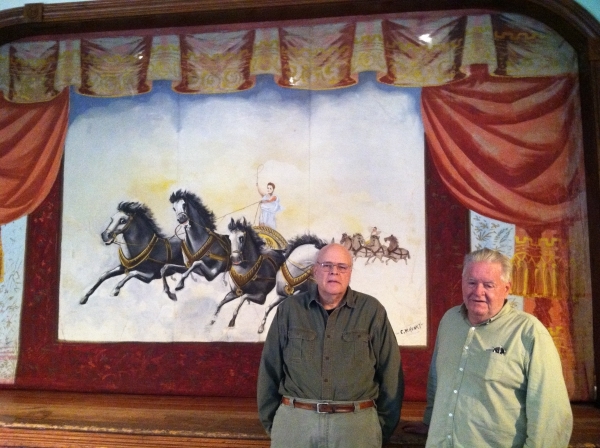GUILFORD — During the weekend of Oct. 7, Guilford Center Stage will present “A Battle of Wits,” a comedy melodrama in four acts, directed by William Stearns. All performances are at the theater company's home base, the Broad Brook Grange.
Don McLean and Laura Lawson Tucker are co-founders and co-producers of the theater company, and “A Battle of Wits” is its third production.
“Part of using the grange is an attempt to get Guilford Center going again, to get people conscious of these little rural villages, to do local things, to keep the building happy and more viable,” McLean said.
The play, written by Guilford native Charles Henry in 1914, takes advantage of another of Henry's artistic creations: the scenic curtains he painted more than 100 years ago.
Henry's theater curtains have garnered some attention in the past few decades with the publication of Christine Hadsel's book, “Suspended Worlds: Historic Theater Scenery in Northern New England,” which catalogs the colorful pieces painted by such artists as William Stuart, based in Brattleboro, and Henry.
Dusty treasures
Hadsel's book brought attention to the almost-lost regional folk art - many panels she found were dusty and torn, neglected in closet corners and attics. Her work led to some curtains' restoration, McLean said.
The grange's four Henry drop curtains include a main drape, which closes off the stage between acts and before and after plays, and three additional panels.
When Hadsel visited the grange to research their Henry curtains, McLean said, “Chris kept telling me about this play Henry wrote.”
McLean researched Henry further and learned he was born in Guilford in 1850, moved shortly after with his family to Brattleboro, then moved to Massachusetts as a teenager. As an adult, he and his wife and children lived in northern Vermont when they weren't on the road with their traveling theater company.
Although Henry's initial career was painting, sewing, and installing theater curtains, “the curtains didn't bring in enough money, so Henry started putting on shows in grange halls and other places like that,” McLean said. Henry's four children helped out in the shows, and each had to learn to play an instrument. Eventually, other adults joined the theater group.
“They put on 'Uncle Tom's Cabin,' 'Ten Nights in a Barroom.' Standard melodramatic fare,” McLean said. “Then Henry realized he could also write plays.” he added, noting only two still exist - although he thinks “there must be more out there.”
Henry debuted “A Battle of Wits” in April, 1915, after his theater troupe stopped touring - and he took over managing the Vergennes Opera House - and two years before his death. “It's sort of his swan song,” McLean said.
“A Battle of Wits” takes place on the eve of the outbreak of World War I, in July, 1914. Most of the action occurs in Strasbourg.
“There doesn't appear to be anything historically inaccurate in the play,” Stearns said. “[Henry] knew about history and current events.”
“He tried educating his audience on European affairs,” McLean said.
European vacation
A married American couple in their 60s are on a grand tour of Germany, Stearns said, “but he's not enjoying any of it, and she's having the time of her life.”
The husband made his fortune growing hops, “and she's buying everything,” Stearns said.
“The American couple are like the Bickersons,” Stearns said, explaining, “they bicker with themselves and use others as a foil. They are classic characters and are the vehicle from which Henry derives the play.”
McLean and Stearns are convinced Henry wrote the part of the male lead for himself.
In the play, the American couple meet an American doctor, a German officer, and a young woman of some mystery. Another German officer and the American doctor fall in love with the woman.
“It's a complicated love triangle,” said Stearns. Then, just as they're all getting acquainted, war breaks out.
“Misadventures ensue, mistaken identities, and intrigue, which is the battle of wits,” Stearns said. That, and whether the American couple, the doctor, and the young woman will make it across the German border to France, “is essentially the play,” Stearns said.
'A rollicking good time'
“Henry was all about people liking his plays,” McLean said. “It's nothing you can't bring your family to” - which is how Henry would often introduce his plays, McLean noted.
“Our intent is to make this a rollicking good time,” Stearns said of his directorial intentions. “It's a little bit over the top. You have to suspend a little disbelief. Essentially, it's cotton candy, even in the midst of the worldwide drama of World War I.”
“That's what Henry liked to do,” McLean added.
Stearns said he liked the script upon reading it, and did some editing to “tighten the awkward language” of the play, which he described as “written in vernacular,” because parts of it are “odd on our contemporary ears,” such as the use of the word “da'sn't” - dares not - which Stearns remembers his grandmother using. She was born in 1874.
He also picked up the play's pace a little, explaining, “we speculated people's attention span was longer [in the early-1900s] than those of us who are plugged in [to modern electronic devices].”
The original play was a long one. “The audience got their money's worth,” Stearns said.
